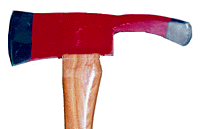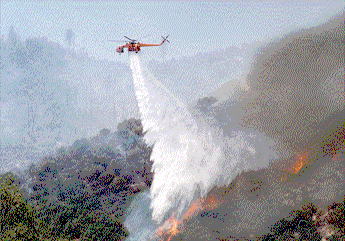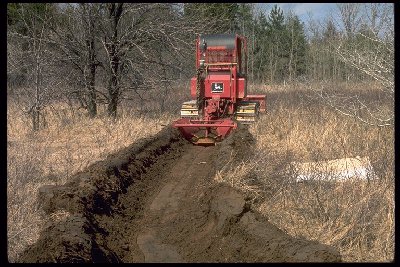Tools:
 A Pulaski |
Wildland firefighters use hand tools, chainsaws, pumps and hose. The primary hand tools are the pulaski--a two-headed tool with an axe on one end and a hoe on the other--and the shovel--sharpened to a fine edge. |
The fire chainsaw market is dominated by Stihl andHusqvarna saws, ranging from about 3.7 to 7.4 cid and 4.6 to 8.6 horsepower.The Stihl 044 and the Husky 266 and 272 probably cut 90% of the fireline in America. The pump of choice is the Wajax Pacific Mark III, pumping 250 gpm. Shindaiwa and Waterous both make smaller pumps, used primarily for mop-up.
Fire fighters in
the southeastern US on occasion use leaf blowers to clear
lines in leaf litter. Alaskan fire fighters use spruce
boughs, swatters--a rubber flap at the end of a pole--and
burlap bags to beat flames down.
Personal
Protetive Equipment:
Firefighters wear shirts and pants from Nomex, a flame-resistant fiber
by DuPont. Boots are leather with
lug soles and tops of at least 8 inches (no steel
toes--the steel heats up in hot ash). White's Boots, especially the Logger/Smoke Jumper, and Nick's Boots (the
Hotshot) are both popular. Polyesters and polypropolenes
are shunned--they melt at the slightest heat.
Hard hats are made from fiberglass or plastic. Gloves are
leather. Sawyers wear chaps made of Kevlar, the same
material found in bulletproof vests (the high tensile
strength of Kevlar allows it to bind the saw's teeth.)
Helicopters:
| Rotor-wing aircraft are essential to modern fire fighting. Helicopters used ranged from the super light Hiller to the Boeing Chinook CH-47D and Sikorsky S-64 Sky Cranes, each of which can lift up to 3000 gallons of water. Light helicopters are used primarily for reconosaince and some crew shuttles. |  Sikorsky S-64 Sky Crane in Action |
The mediums, Bell 204s, 205s, 212s and 214s are the all-pupose workhorses of the fire service. Able to carry about 1200 lbs at sea level and 600 lbs at 8000 feet, they're used as crew shuttles, rappel platforms, cargo haulers, and water droppers. The heavies are used primarily to drop water, and occasionally to ferry supplies.
For more
information, visit: Aerial
Firefighting Industry Association, Sikorsky Aircraft Corporation
Fixed-wing
aircraft:
Fixed-wings do reconnosaince and drop smokejumpers,
water, and retardant. From Cessna 207s to the Canadiar CL-415 SuperScooper to the Boeing 737s
chartered by the National Interagency Fire Center, they
are essential to modern fire operations. The primary jump
planes are the Sherpa, the Casa 212, the Bandit, and the
DeHavilland Twin Otter.
Heavy
Equipment:
 A tractor plow builds line |
In the West, bull dozers are used to build fireline on flatter ground. In the Midwest and Southeast, tractor plows are often used to construct fuel breaks. The Texas Forest Service recently began using a military surplus tracked vehicle as an engine. |
Other:
Few fires are fought in the Boundary Waters of Minnesota
or the Quetico National Park in Ontario without canoes,
sometimes lifted in by float planes (the Superior
National Forest has 2 Beavers).